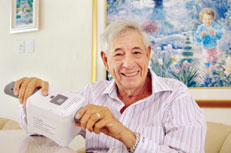THE first time Howard County, Md., inventor Dr. Robert Fischell experienced a migraine symptom known as an aura, he had no clue what was happening. Images of dancing circles crowded his vision, and when the circles grew larger, he thought he was about to have a stroke. Suddenly, the aura stopped and to Fischell’s surprise, and relief, no ailment followed. “Oh, thank God,” he said.
Now the maker of the first implantable insulin pump, the rechargeable pacemaker and various coronary stents has invented a hand-held device that targets the aura en route to stopping a migraine — a painful, sometimes debilitating headache disorder — before it starts.
Fischell’s Neuralieve Transcranial Magnetic Stimulation, or TMS, Treatment System device is creating a buzz throughout medical circles — and could provide hope for the millions of Americans who suffer from aura-accompanied migraine headaches.
Having received satisfactory results in testing the device, Fischell applied to the US Food and Drug Administration in June for approval to manufacture the device for commercial sale. He hopes the device will be on the market (via prescription only) by the beginning of next year.
Fischell’s noninvasive device marks a significant advance in TMS technology, which doctors and scientists have used since the 1980s to probe brain activity and, in recent years, to treat depression.
Fischell’s contraption looks like a box with two handles on opposite sides. At the onset of an aura — a neurological disturbance during which nerves in the brain spontaneously fire — the user places the device at the back of his head near the part of the brain called the occipital cortex, where auras begin. The press of a trigger on the device emits two magnetic pulses 15 seconds apart. The pulses silence the nerve activity, shutting down the aura before migraine pain sets in.
And while the TMS treatment for migraine headache is largely in its experimental phase, it has not been associated with serious side effects. Treatments to stem migraine-accompanied aura include applying steroids directly to the occipital cortex. “The magnetic pulses are equivalent to what you get during an MRI, the intensity of the magnetic field,” said Fischell, 79. “The patients do feel a tingle in their scalp, which is not at all unpleasant. That is really our only side effect, and it is not at all a problem. It merely indicates to the patient that there has been a treatment. Medications are somewhat effective, but they all have side effects. Our treatment has zero side effects.”
The New Jersey-based American Headache Society, a professional society of health-care providers, estimates that 28 million Americans — about one in five women and one in 20 men — suffer from migraines with or without aura. The higher incidence for women is probably related to fluctuation in estrogen, said Jack Gladstein, associate professor of pediatrics and neurology at the University of Maryland School of Medicine.
In a clinical trial involving the Neuralieve TMS and a replica device, Fischell’s machine outperformed the replica, with 39 percent of its users pain-free at two hours after treatment, compared with 22 percent of placebo users who didn’t have pain after two hours. At both the 24-hour and 48-hour intervals, the number of TMS-treated patients free from pain was 13 percent greater than that of the placebo groups at the respective intervals. None of the patients reported serious side effects.
“Those with the placebo device, the headache eventually went away by itself,” said Dr. Stephen D. Silberstein, director of the Jefferson Headache Center in Philadelphia, one of 16 medical facilities in the US where the Neuralieve was tested. “The headaches in all the subjects went away, but it went away much faster for those using the device than those not using the device.”
Fischell’s latest invention may give benefits to sufferers of migraine aura, although as Fischell discovered, not all auras are followed by migraine.
In fact, for some, aura occurs during migraine. For others, it doesn’t occur at all.
“Migraine is a mechanism that is built into the human brain. We all possess it, and it becomes active by an efficient build-up of its triggers,” said David Buchholz, associate professor of neurology at the Johns Hopkins University and author of a self-help guide, “Heal Your Headache.” Migraine triggers include stress, hormones, weather changes, sleep, certain foods (a long list that includes caffeine, nuts, vinegar and processed meats) and acid reflux drugs.
“You can tolerate those triggers to a point,” Buchholz said. “But once those triggers rise above the threshold, migraine becomes activated and symptoms occur.”
The result is the swelling of blood vessels outside the brain (which causes the pain) and the constriction of blood vessels inside the brain (causing the aura). “The degree of symptoms depends on how high above the threshold your triggers are,” Buchholz said.
Some medicines can make matters worse. They relieve the pain, but can lower a person’s migraine threshold. Others can cause dizziness, hair loss, increased appetite, constipation and tremors.
“I used to have migraines and some medicines made me sicker than the headache,” the Jefferson’s Silberstein said. “This is a non-drug treatment for bad headaches. That’s why it’s important.”


